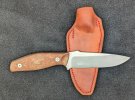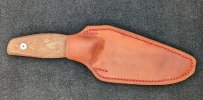Horsewright
Knifemaker / Craftsman / Service Provider
- Joined
- Oct 4, 2011
- Messages
- 13,832
Different leathers shrink at different rates too. I'm pretty big on using a welt cut from the same side as the sheath. Many times I've seen it where the welt when not so cut, will shrink more than the sheath. Easy enough to fix if you have a sander and room on your stitching line, but....Easier yet not to do it in the first place. I often stretch wet leather. Did last night. One sheath in the batch was a little tight around the throat for its knife. I used a pair of needle nose pliers inside and opened them up stretching the leather where it needed to be stretched.



